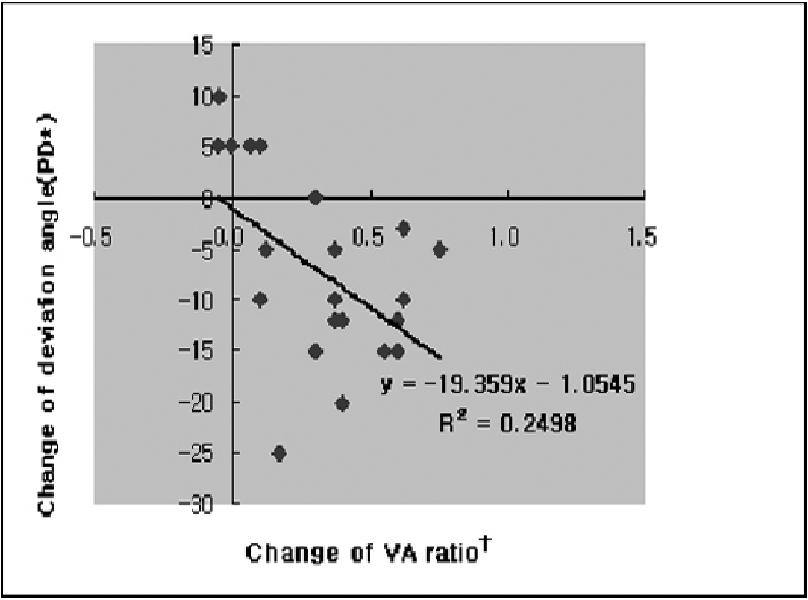Korean J Ophthalmol.
2007 Sep;21(3):159-162. 10.3341/kjo.2007.21.3.159.
Reduction of Deviation Angle During Occlusion Therapy: In Partially Accommodative Esotropia with Moderate Amblyopia
- Affiliations
-
- 1Department of Ophthalmology, Kyungpook National University, School of Medicine, Daegu, Korea. jykwon@mail.knu.ac.kr
- KMID: 1099032
- DOI: http://doi.org/10.3341/kjo.2007.21.3.159
Abstract
- PURPOSE: To evaluate changes in ocular alignment in partially accommodative esotropic children age ranged from 3 to 8 years during occlusion therapy for amblyopia. METHODS: Angle measurements of twenty-two partially accommodative esotropic patients with moderate amblyopia were evaluated before and at 2 years after occlusion therapy. RESULTS: Mean deviation angle with glasses at the start of occlusion treatment was 19.45+/-5.97 PD and decreased to 12.14+/-12.96 PD at 2 years after occlusion therapy (p<0.01). After occlusion therapy, 9 (41%) cases were indications of surgery for residual deviation but if we had planned surgery before occlusion treatment, 18 (82%) of patients would have had surgery. There was a statistical relationship between increase of visual acuity ratio and decrease of deviation angle (r=-0.479, p=0.024). CONCLUSIONS: There was a significant reduction of deviation angle of partially accommodative esotropic patients at 2 years after occlusion therapy. Our results suggest that occlusion therapy has an influence on ocular alignment in partially accommodative esotropic patients with amblyopia.
Keyword
MeSH Terms
Figure
Cited by 1 articles
-
The Effect of Amblyopia Treatment with Patching on Ocular Alignment
Seung Woo Kim, Seung Ah Chung
J Korean Ophthalmol Soc. 2016;57(2):302-309. doi: 10.3341/jkos.2016.57.2.302.
Reference
-
1. Von Noorden GK, Campos EC. Binocular Vision and Ocular Motility. 2002. 6th ed. St. Louis: Mosby;311–355.2. Lee JB, Han SH, Kwon JY, et al. Current Concepts in Strabismus. 2004. Seoul: Naewaehaksul;chap. 7.3. Wright KW, Edelman PM, Walonker F, Yin S. Reliability of fixation preference testing in diagnosing amblyopia. Arch Ophthalmol. 1986. 104:549–553.4. Lam GC, Repka MX, Guyton DL. Timing of amblyopia therapy relative to strabismus surgery. Ophthalmology. 1993. 100:1751–1756.5. Koc F, Ozal H, Yasar H, Firat E. Resolution in partially accommodative esotropia during occlusion treatment for amblyopia. Eye. 2006. 20:325–328.6. Holbach HT, Von Noorden GK, Avilla CW. Changes in esotropia after occlusion therapy in patients with strabismic amblyopia. J Pediatr Ophthalmol Strabismus. 1991. 28:6–9.7. Kim S, Kim S, Cho YA. Deterioration of accommodative esotropia during part-time occlusion therapy. Korean J Ophthalmol. 2005. 19:77–79.8. Repka MX, Holmes JM, Melia M, et al. The effect of amblyopia therapy on ocular alignment. J AAPOS. 2005. 9:542–545.
- Full Text Links
- Actions
-
Cited
- CITED
-
- Close
- Share
- Similar articles
-
- Clinical Assessment of Partially Accommodative Esotropia
- Deterioration of Accommodative Esotropia during Part-time Occlusion Therapy
- Dissociated Horizontal Deviation in the Refractive Accommodative Esotropia with Amblyopia
- Clinical Features of Refractive Accommodative Esotropia and Partially Accommodative Esotropia
- The Comparison of Surgical Results Between Non-accommodative and Partially Accommodative Esotropia



